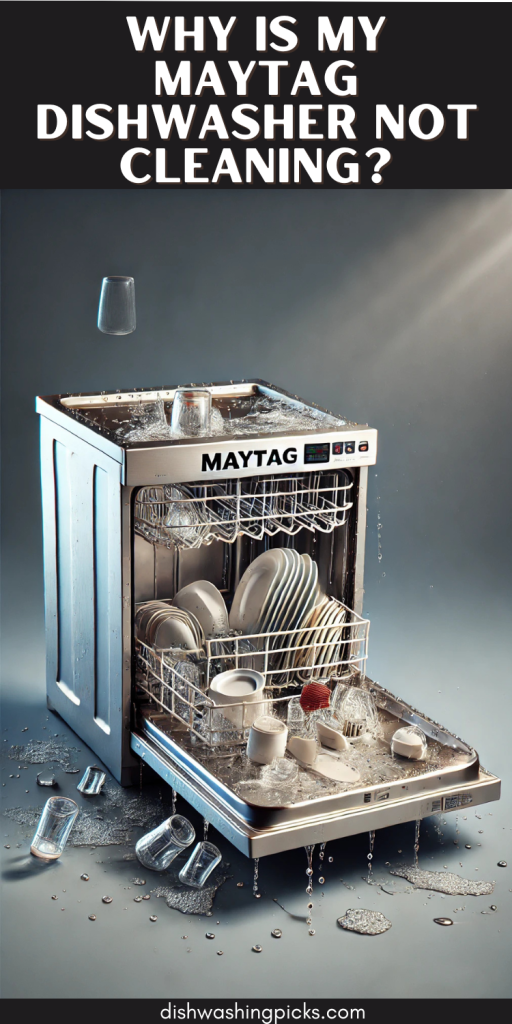
Picture this: You open your dishwasher, expecting sparkling clean dishes, but instead, you find crusty food bits and streaky glasses. Frustrating, right? If your Maytag dishwasher isn’t cleaning properly, don’t worry—you’re not alone. The good news? Most of the time, it’s an easy fix!
Before you start panic-Googling “new dishwashers,” let’s go step by step and figure out why your Maytag isn’t pulling its weight.
1. Are You Loading It the Right Way?
Believe it or not, how you load your dishwasher really matters. If your dishes are stacked too tightly or blocking the spray arms, water and detergent can’t reach everything, leaving you with half-clean plates.
How to Load Like a Pro:
- Top Rack: Cups, glasses, and small bowls. Angle them slightly so water doesn’t pool inside.
- Bottom Rack: Plates, larger bowls, and pots—space them out so water can circulate.
- Silverware Basket: Mix forks, spoons, and knives so they don’t “nest” together and stay dirty.
Pro Tip: Avoid blocking the detergent dispenser! If a plate or pan is in the way, the detergent may not release properly, leaving you with a soapy, ineffective wash.
2. Is the Filter Clogged? (Hint: It Probably Is!)
Think of your dishwasher filter like a lint trap in a dryer—it catches food bits, preventing them from redepositing on your dishes. But if it’s clogged, dirty water just keeps cycling through, leaving your dishes anything but clean.
How to Check & Clean Your Filter:
- Find It – Most Maytag dishwashers have a removable filter at the bottom. Just twist and lift it out.
- Rinse It – Use warm water and a soft brush to scrub off grease and debris.
- Check the Drain Area – If there’s gunk around the drain, clear it out!
How Often? – If you rinse your dishes first, clean it every few months. If you’re a “straight from plate to dishwasher” person (no judgment), check it monthly.
3. Are the Spray Arms Spinning Freely?
Spray arms are like tiny water wands, blasting away grime. But if they’re clogged or blocked, your dishwasher is just swirling around sad, soapy water.
What to Do:
- Give them a spin (literally). If they hit anything, adjust your dish placement.
- Check for clogs – Use a toothpick to clear out tiny holes where hard water or food bits might be stuck.
- If they’re grimy, soak them in vinegar to break down buildup.
Fun Fact: A blocked spray arm might mean only the top or bottom rack is getting cleaned—ever notice one comes out cleaner than the other? That’s why!
4. The Detergent Dilemma: Are You Using the Right One?
Not all dishwasher detergents are created equal! Cheap or expired detergent can leave behind residue, making your dishes look worse.
Best Practices:
- Use a high-quality detergent—tablets or pods usually work best.
- Hard water? Consider adding a rinse aid to prevent spots and buildup.
- Store detergent in a dry place—moisture clumps it up, making it less effective.
Warning Signs: If your glasses look cloudy, your detergent might not be cutting it. Time to upgrade!
5. Is Your Water Hot Enough?
Here’s a sneaky culprit: If your water isn’t hot enough, detergent won’t dissolve properly, and grease won’t break down. Maytag recommends a minimum 120°F (49°C) for best results.
Easy Test:
Run your kitchen sink on hot and time how long it takes to warm up. If it takes too long, your dishwasher might not be getting hot water fast enough. Try running hot water before starting a cycle to help.
6. Hard Water Might Be Ruining the Clean
If your dishes come out looking filmy or spotty, hard water could be the problem. Hard water contains minerals like calcium and magnesium that leave behind residue, making everything look dull.
How to Fix It:
- Use Rinse Aid – This helps prevent mineral buildup and improves drying.
- Try a Dishwasher Cleaner – A monthly cleaning cycle with a descaler like citric acid or vinegar can break down hard water deposits.
- Water Softener? – If you have extremely hard water, consider a whole-home water softener to improve dishwasher performance.
Pro Tip: If you see white buildup on the heating element, that’s a clear sign of hard water issues!
7. Is the Door Seal Leaking?
If your dishwasher isn’t sealing properly, it can’t maintain water pressure or heat—both essential for a deep clean. A faulty door seal can also lead to water leaks on your kitchen floor.
How to Check:
- Look for gaps, cracks, or mold along the rubber gasket.
- If the seal feels brittle or worn, replace it (most are cheap and easy to install).
- Shut the door and listen—if it doesn’t sound snug, it might not be sealing right.
Why It Matters: A poor seal = weaker wash cycles = dirty dishes!
8. When to Call for Backup (a.k.a. Professional Help)
Tried everything and your Maytag still won’t clean like it used to? It might be time for a repair. Some issues require expert attention, like:
A broken circulation pump (not spraying water properly).
A faulty heating element (if water isn’t hot enough).
Control board issues (if cycles aren’t running correctly).
Is Repair Worth It? – If your dishwasher is 5+ years old, compare the repair cost to a new model—sometimes, an upgrade is the smarter move.
Final Thoughts: Get Your Maytag Back in the Game!
Your Maytag dishwasher should be a cleaning powerhouse, not a dish-rinsing disappointment. By checking for clogs, water temperature, detergent quality, and part malfunctions, you can get it back to peak performance.
Your next step? Run through these fixes, and let me know which one worked for you! Still stuck? Drop your issue in the comments—I’ve got more dishwasher wisdom to share!
